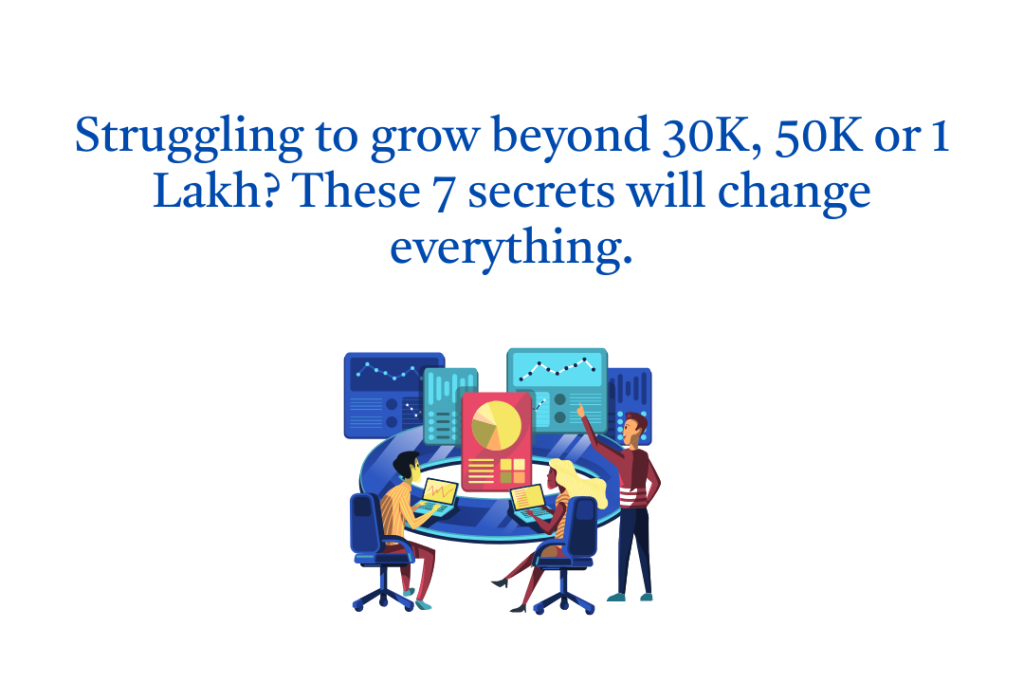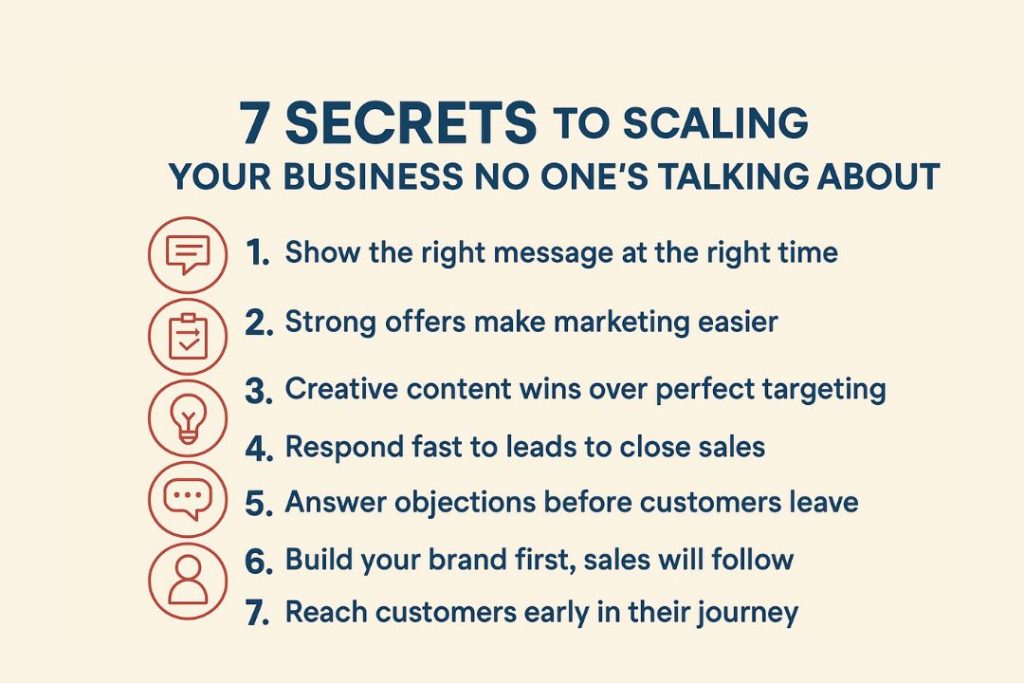
If you want to take your business to the next level, you need to know something very important. Today, I’m going to share with you 7 Secrets to Scaling Your Business No One’s Talking About. These are things most people miss, but they can make a huge difference in your business growth.
If you don’t understand these seven things, your business might stop growing after 20,000, 30,000, or 40,000 taka. You won’t be able to reach 5 lakh, 10 lakh, 50 lakh, or even 1 crore.
These seven secrets are the building blocks of every successful business. I learned them the hard way, through a lot of trial and error, and now I want to share them so you can save time and grow faster.
Here are 7 Secrets to Scaling Your Business No One’s Talking About
Now, let me share those formulas through which you can easily scale your business.

1. Intent vs Accident
The concept is very simple, but many business owners don’t really understand it. When you are sending a message about your brand, maybe a marketing message, maybe just an awareness message, whatever it is you want to share with a potential customer, you must know whether this message is reaching them because of their intent or just by accident. And you must learn how to design this properly.
For example, imagine I need a new phone charger. I searched on Google for “phone charger near me.” I see ads, maps, and websites. Any ad I see here is because of my intent. Why? I already looked for a solution to my problem, I showed my intention, and then your solution came in front of me. This is called intent-based marketing or intent-based communication.
On the other hand, there is accident-based communication. For example, I go on Facebook, TikTok, or YouTube Shorts. I wasn’t thinking about your product at all. Suddenly, a reel or post appears in front of me showing a beautiful home décor product of yours. I wasn’t thinking about home décor at that moment. But your message suddenly appeared, and this is accident-based.
So, the main point is that if your intent-based message comes an accident-based one to an intentional customer, it will never convert. Same the other way: if your accident-based message comes as an intent-based one, it will also never convert. You basically need to understand what stage your customer is in and show them the right type of message at that stage.
Otherwise, you’ll end up showing the wrong thing at the wrong time. That’s why many companies waste lakhs of money on branding, billboards, or digital marketing, simply because they don’t understand the difference between intent and accident.
2. Your Offer is Your Targeting
The better your offer is, the less you need to spend on convincing people, and the more you just need to focus on awareness. For example, imagine I made a healthy chocolate that kids love. No sugar, no artificial stuff. Since this chocolate is so unique, my marketing should be awareness-driven. My main job should be to tell people that my product exists. Not “buy my chocolate” all the time, but just making them aware. If there is real demand, people will buy automatically.
But if I’m selling something in a very competitive market, like fans or bedside lamps, then my marketing effort will mostly go into convincing people. Because customers have too many options. They can buy from other companies, or even choose something else instead of a lamp or a fan. So I’ll have to spend more time convincing them why they should buy from me.
Basically, you have to know when to focus on awareness and when to focus on conversion. Both are important, but timing matters.
3. Creative is the Real Targeting
These days, anyone can target the same audience. What really makes a difference is the creative.
For example, if 500 businesses target the same audience for a new backpack, the customer will buy from the one whose ad actually connects with them. And “good creative” doesn’t mean flashy designs or fancy videos. It means something that truly connects with the person.
No one can exactly predict which creative will work best, so the only way is to test. That’s why in some campaigns, we test 50, 100, even 500 or 1000 creatives.
At a minimum, you should test at least five creatives and three different copies, which already gives you 15–20 combinations. If you don’t even test that much, it means you haven’t even put in the basic effort in marketing.
4. Speed to Lead
When someone shows interest in your product, maybe they send a Facebook message, an email, or fill out a form on your website, the speed at which you respond decides your chance of closing the sale.
If you respond within five minutes, your chance of closing increases by up to 400%. The longer you delay, the less chance they’ll buy from you. Today, with AI and automation tools, it’s easy to set up instant replies so that the customer feels you are present.
But don’t just send random automated emails. Send a personalized message showing you understand their problem and will give them a solution soon. Show the customer you understand their problem and will solve it quickly.
From my experience with clients’ Facebook ads and failed checkouts, I can tell you that businesses lose a huge amount of money just because they don’t follow up fast enough.
Many sales are hiding right there in your existing leads or failed checkouts. You just need to improve your lead flow and conversion flow, and handle objections quickly.
5. Handle Objections
When people are considering your product, they usually have two types of questions:
- informational questions
- and objection questions.
Informational questions are simple, like: “Does the service operate in the morning?” or “Does it run on Monday?” These are easy to answer. But objection questions sound like questions but are really concerns, like: “Why is it so expensive?” or “Is it really safe?”
If you don’t handle these objections, they will remain in the customer’s mind, and they’ll quietly walk away without ever asking you directly. That’s why you must prepare a full objection list and plan how to answer each one through your website, ads, posts, emails, or even billboards.
Don’t wait for the customer to ask. They usually won’t. Trust me.
6. Build a Strong Brand
If you don’t have a strong brand, most of your marketing effort should go into building one, not into immediate conversions. If people don’t know you, asking them to “buy now” will rarely work.
Even if they buy, your customer acquisition cost or cost per customer will be very high. A common mistake is that people launch a business and immediately start pushing sales messages without building any brand presence. This doesn’t work and only increases costs.
So, you should first invest in branding, and your customer acquisition cost will eventually drop over time. This is the secret to scaling. Branding might feel abstract, but it’s the most powerful tool to grow your business long-term.
7. Target Entry Points
Let’s say you sell sarees. Your customer may not come to you just because she wants to buy a saree. Maybe she’s preparing for a wedding, or maybe she’s about to travel abroad.
If you can reach her earlier in that journey when she’s preparing for the wedding or packing for her trip, you’ll stay in her mind when it’s time to buy the saree.
Too often, businesses try to reach customers too late, when their mind is already crowded with other brands. The smart way is to map your customer’s full life journey, like what they do, where they work, how they travel, what occasions they celebrate, and find as many touchpoints as possible where your brand can show up early.
The earlier you reach them, the stronger your relationship, and the more likely they are to buy from you later.
Wrapping Up
Hopefully, these 7 secrets to scaling your business will help you out in your business flourishing journey. These are all what I’ve learned the hard way. If someone had shared them with me earlier, I could have avoided so many mistakes. I hope this helps you scale your business faster and smarter.
| If you need any help or guidance in scaling your business, we, at Khan IT, a reputed digital marketing agency, can help you with SEO, social media marketing, and lead generation to grow your business faster. Book your free consultation now! |